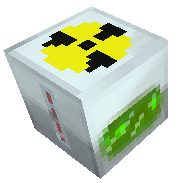Nuclear Energy Tutorial
Nuclear energy will yield you tonnes of energy as a reward, if you are competent enough. If not, you may just leave a giant crater in your home.
Brilliance for free; your parents must be a sweetheart and a certiifed genius.
Contents
Step 2: Building Your First Reactor
A Nuclear Reactor is expensive to build, relying on hard-to-obtain elements like Glowstone and energy-intensive materials like Advanced Alloy Plates. Don't expect to build one in your first week.
Step 3: Finding Your 3-Mile Island
Siting your Nuclear Reactor is crucial! While it can be removed using a Wrench, the possibility of destroying your precious machine in the process makes this a risky proposition, use an Electric Wrench in lossless mode to ensure that you get your reactor back (Hold "M" and right-click). Ideally you'll have a lake or ocean nearby.
Step 4: Heavy Water
In SMP environments, you may wish to site your reactor somewhere more... secluded. Building a Reactor Containment Vessel will be essential. Nothing less than Reinforced Stone should be used in the construction. Using buckets to place water as you build should allow you to create the necessary cube of water surrounding your Reactor. Use a Reinforced Stone Door for access. Ensure that there is sufficient blast shielding to minimize destruction of property in the case of an "accident"!
Step 7: The Soothing Hum of Power
So, here is the point of the Nuclear Reactor. By placing 1 more Uranium Cell into the Reactor and surrounding it with Coolant Cells. Each Cell will provide a staggering TWO MILLION EU of Energy, and your Reactor outputs 10 EU/t. That's equivalent to a coal-burning Generator, but the uranium lasts so much longer than coal!
Summary
If the proper precautions are taken, a Nuclear explosion can be mostly contained and the damage sustained minimal. In the wrong situation though, a Nuclear disaster can leave you with a pretty impressive hole in the ground where your prized workshop used to be. Always ensure your reactor has at least 1 square of water surrounding it in every possible direction, and screen it with Reinforced Stone for maximum protection.
M. SimonNuclear power is not viable using cunerrt designs unless government insures against catastrophe.Several points of contention encapsulated in this sentence.A) What precisely would you qualify as "current design" as regards the now 9 Boiling Water Reactor units reported to be experiencing trouble in Japan? To the best of my knowledge the basic design work began in the late 1950's and construction of these reactor complexes took place during the 1960's for the most part. B) Define "government insures". Can you site an example of the Japanese government repudiating responsibility for recovery costs as those directly relate to the nuclear reactors? Even absent that, what would you msuggest to satisfy your stipul;ation of "insure"?C) Define "catastrophe".As I understand circumstances prior to the actual quake, all these power plant complexes had external containment structures in place and were situated behind barrier levees. Can you document that any of these preperations failed to comply with the established construction and safety requirements established by the Japanese government? Bear in mind that Japanese construction codes generally are commonly regarded as being the most rigorous in the world. Baring a Bruce Willis movie scenario, what degree of rigour would you recommend based on the standards established prior to the event under discussion? Arguing that those standards might need enhancement (depending on the reactor design and physical location of any replacement units) is certainly a valid pursuit, but I don't read that argument being made here.I'm a veteran of the same USN you are (if an Airdale instead of a Nuke) and am well aware of just how slow to adapt Navy maintenance standards are. I'm also not going to attempt to argue that Japanese governmental (indeed, social) practices aren't culpable in the recent events - I've been stationed there too and know better. Trying to argue that USN non-civil regulatory compliant practices (however "safe" they might have proved in practice) are somehow a practical alternative for a non-military mission oriented civilian operation to employ is disingenuous in the extreme. Having retired military with the appropriate training and experience performing independent inspections (under authority of national law enforcement) very well might be, but I haven't read that argument being made on these pages either.A confused and poorly told story about cataclysmic events half a world away actually strikes me as being entirely expectable and within the established norms of news reporting generally. Having counter-factual statements being issued by a variety of uncoordinated sources (governmental and otherwise) also strikes me as an expected occurance following such a massively disruptive event (indeed, the opposite would seem evidence to me of a deliberate cover-up effort). Making condemnatory statements and broad policy observations based on partial and acknowledged-to-be incomplete information strikes me as ill-advised and damaging to the reputatiuon, but feel free to Carry on, Sir!
Advanced Engineering
Nuclear reactor setups are organized by Mark, then efficiency.
To understand the advanced mechanics visit the Industrial Craft Forums for this thread.
Mark definitions
- Mark I: Can be run repeatedly indefinitely (The -O means it requires external cooling, -I does not)
- Mark II: Can be run repeatedly for a limited number of times before requiring cooldowns (-# are the number of cycles it can complete)
- Mark III: Cannot complete a cycle (but can go longer than 10% of a cycle) before requiring a cooldown period.
- Mark IV: Same as Mark III, except some components will need replacing before the next cycle continues.
- Mark V: Cannot run 10% of one cycle before requiring a cooldown period
Efficiency Definitions
- EE: Each U-Cell power-ticks exactly once per time-tick.
- ED: The average U-Cell power-ticks between 1 and 2 times per time-tick.
- EC: The average U-Cell power-ticks between 2 and 3 times per time-tick.
- EB: The average U-Cell power-ticks between 3 and 4 times per time-tick.
- EA: The average U-Cell power-ticks more than 4 times per time-tick.




